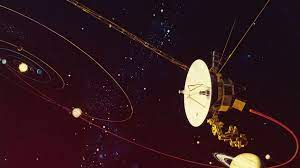Using multiple antennas, NASA’s Deep Space Network (DSN) was able to detect a carrier signal from Voyager 2. A carrier signal is what the spacecraft uses to send data back to Earth. The signal is too faint for data to be extracted, but the detection confirms that the spacecraft is still operating. The spacecraft also continues on its expected trajectory. Although the mission expects the spacecraft to point its antenna at Earth in mid-October, the team will attempt to command Voyager sooner, while its antenna is still pointed away from Earth. To do this, a DSN antenna will be used to “shout” the command to Voyager to turn its antenna. This intermediary attempt may not work, in which case the team will wait for the spacecraft to automatically reset its orientation in October.
A series of planned commands sent to NASA’s Voyager 2 spacecraft July 21 inadvertently caused the antenna to point 2 degrees away from Earth. As a result, Voyager 2 is currently unable to receive commands or transmit data back to Earth.
Voyager 2 is more than 12.3 billion miles (19.9 billion km) from Earth, where it is hurtling at an estimated 34,390mph (55,346km/h) through interstellar space - the space between the stars.
Since 21 July, the probe has been unable to receive commands or send back data to Nasa's Deep Space Network - an array of giant radio antennas across the world - and the spacecraft is not receiving commands from ground controllers.
Earlier on Monday, the space agency said its huge dish in Australia's capital, Canberra, was trying to detect any stray signals from Voyager 2.
The antenna has also been bombarding Voyager 2's area with the correct command, in the hope of making contact with the probe, said Nasa's Jet Propulsion Laboratory, which manages the Voyager missions.
Voyager 2 certainly knows its way around the cosmos - it was launched way back in 1977.
It's managed by NASA's Jet Propulsion Laboratory in California and is the only spacecraft to have visited either Neptune or Uranus - our Solar System's ice giant planets.
It's also visited gas giants Jupiter and Saturn.
Its identical twin, Voyager 1, is also still in space and in touch with Earth from a whopping 15 million miles away. It's humanity's most distant spacecraft.
Both craft are to be powered down over the next few years, potentially as soon as 2025.
Read more
London wins £2.9 million in Premium Bonds August 2023 YORKSHIRE DAY 1st of AugustSarah H
Also on site :
- A look at six bills in Albany awaiting Gov. Hochul’s signature
- Israel tried to break Iran – but it may have actually helped unite it
- This 'Iconic' Cereal is Finally Making a Comeback and Fans Going Wild: 'Holy Smokes'

